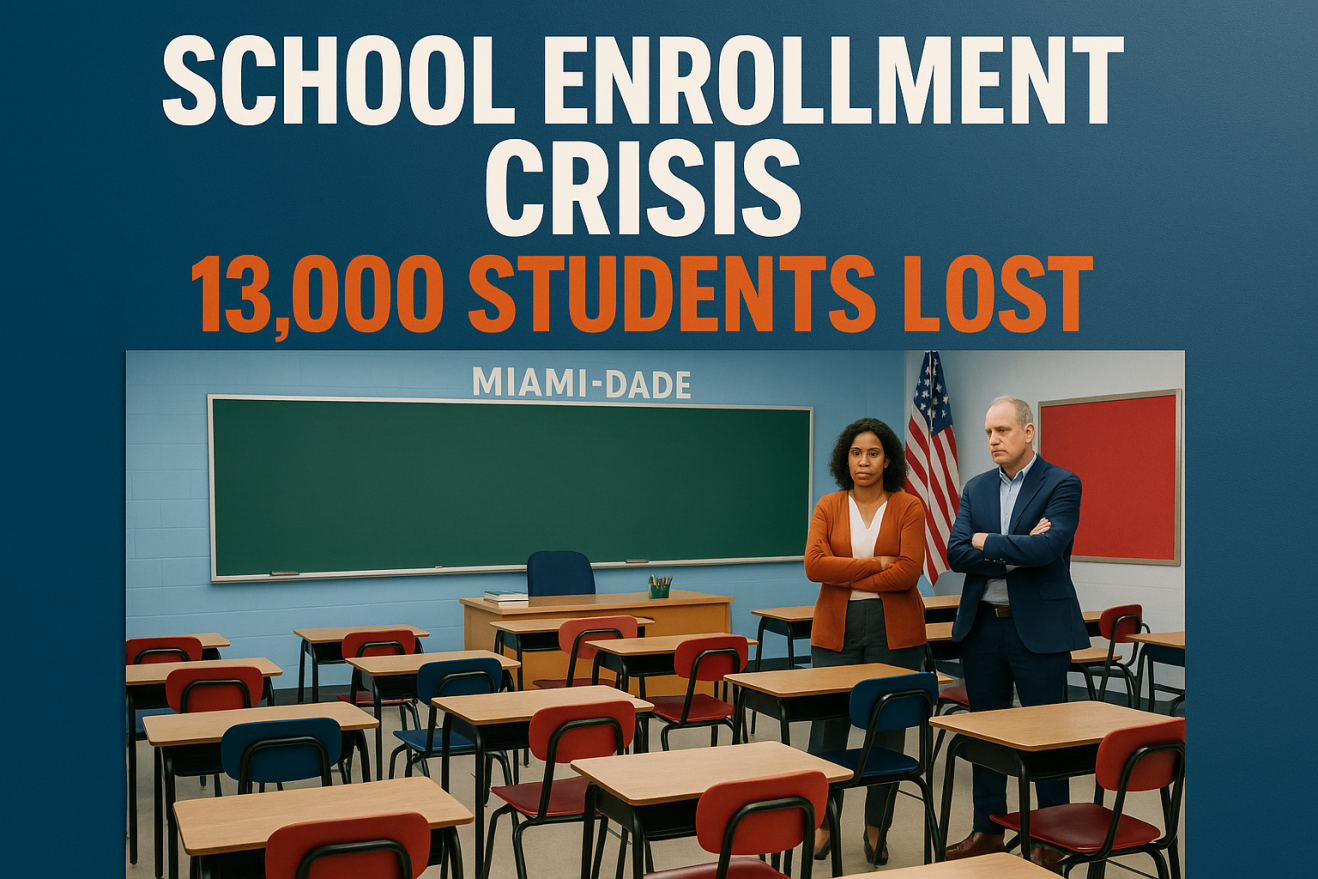MIAMI – Miami-Dade County Public Schools, the nation’s fourth-largest school district, is grappling with a significant enrollment crisis as initial 2025-2026 academic year data reveals 13,059 fewer students than the previous year – a 4% decrease that has sent shockwaves through the educational community and raised urgent questions about the future of public education in South Florida.
The Numbers Tell a Troubling Story
The enrollment decline represents one of the most significant single-year drops in the district’s recent history. Superintendent Dr. Jose L. Dotres acknowledged the concerning trend during a recent school board meeting, noting that the decrease affects funding, staffing, and program availability across the district’s 392 schools.
“While we anticipated some enrollment adjustments, the magnitude of this decline requires immediate attention and strategic response,” Dr. Dotres stated during his presentation to the Miami-Dade School Board. “We must understand the underlying factors driving families away from our public schools.”
Multiple Factors Drive Student Exodus
Education experts point to several interconnected factors contributing to the enrollment decline. The expansion of Florida’s school choice programs, including increased funding for private school vouchers and charter school growth, has provided families with more alternatives to traditional public schools.
The Florida Department of Education’s expanded voucher programs, including the Family Empowerment Scholarship, now serve over 130,000 students statewide, with a significant portion in Miami-Dade County.
Charter School Competition Intensifies
The proliferation of charter schools in Miami-Dade has created unprecedented competition for traditional public schools. The district now hosts over 200 charter schools, many of which have attracted families seeking specialized programs, smaller class sizes, or alternative educational approaches.
Dr. Maria Rodriguez, education policy analyst at Florida International University, noted that charter schools have particularly appealed to families seeking bilingual education, STEM-focused curricula, or arts-integrated programs that may not be available at their neighborhood public school.
Economic and Demographic Shifts
The enrollment decline also reflects broader demographic and economic changes in Miami-Dade County. Rising housing costs have forced many families to relocate to more affordable areas in Broward, Palm Beach, or other Florida counties, taking their children with them.
Additionally, some families have moved out of state entirely, seeking lower costs of living or different educational opportunities. The U.S. Census Bureau data shows that Florida’s population growth has slowed in recent years, with some metropolitan areas experiencing net out-migration for the first time in decades.
Financial Implications for the District
The enrollment decline carries significant financial consequences for Miami-Dade Public Schools. Florida’s per-pupil funding formula means that fewer students directly translate to reduced state funding, potentially impacting everything from teacher positions to program offerings.
Each student represents approximately $8,000-$10,000 in annual funding, meaning the 13,059 student decrease could result in a funding reduction of $100-130 million. This financial impact comes at a time when the district is already facing budget pressures from inflation, teacher salary increases, and infrastructure needs.
Chief Financial Officer Jennifer Martinez warned that the district may need to consider difficult decisions regarding staffing and program cuts if enrollment trends continue.
Teacher Shortage Compounds Challenges
The enrollment decline occurs amid an ongoing teacher shortage that has affected schools nationwide. Miami-Dade has struggled to fill teaching positions, particularly in high-need subjects like mathematics, science, and exceptional student education.
The United Teachers of Dade union has advocated for increased teacher pay and improved working conditions to address recruitment and retention challenges. Union president Karla Hernandez-Mats noted that teacher shortages can create larger class sizes and reduced program offerings, potentially driving more families to seek alternatives.
Academic Performance and Accountability Pressures
Miami-Dade’s academic performance, while showing improvement in some areas, continues to face scrutiny under Florida’s school accountability system. Some schools have received low grades, leading families to seek higher-performing alternatives.
The district’s efforts to improve academic outcomes include expanded Advanced Placement offerings, enhanced career and technical education programs, and increased focus on literacy and mathematics instruction.
COVID-19’s Lasting Impact
The pandemic’s effects on education continue to influence family decisions about schooling. Some parents who turned to homeschooling or private schools during COVID-19 have chosen not to return to public education, while others remain concerned about health and safety protocols.
Remote learning experiences during the pandemic also introduced families to educational alternatives they might not have previously considered, including online schools and hybrid learning models offered by private providers.
District Response and Strategic Initiatives
Superintendent Dotres has announced several initiatives aimed at addressing the enrollment decline and improving the district’s competitiveness. These include enhanced magnet school programs, expanded dual enrollment opportunities with local colleges, and improved communication with families about available programs and services.
The district is also investing in facility improvements and technology upgrades to enhance the educational experience and attract families back to public schools. A new community engagement strategy aims to better communicate the district’s strengths and achievements to families and the broader community.
Implications for School Choice Policy
The enrollment trends in Miami-Dade reflect broader debates about school choice policy in Florida and nationwide. Supporters of expanded choice options argue that competition improves educational quality and provides families with options that better meet their children’s needs.
Critics worry that school choice policies may undermine traditional public schools and create inequities, particularly for families who lack the resources or information to navigate complex choice systems.
Looking Ahead: Challenges and Opportunities
As Miami-Dade Public Schools confronts this enrollment challenge, district leaders are focusing on both immediate responses and long-term strategic planning. The district’s strategic plan emphasizes innovation, equity, and excellence as core priorities.
Key initiatives include expanding early childhood education programs, enhancing career pathway offerings, and strengthening partnerships with local businesses and higher education institutions. The district is also exploring ways to better serve diverse student populations, including English language learners and students with disabilities.
Community and Stakeholder Engagement
Addressing the enrollment decline will require collaboration among multiple stakeholders, including parents, teachers, community leaders, and elected officials. The Parent Academy and various community organizations are working to increase family engagement and support student success.
Local business leaders and civic organizations have also expressed concern about the implications of declining public school enrollment for the region’s economic competitiveness and workforce development.
As the 2025-2026 school year progresses, Miami-Dade Public Schools faces the critical challenge of not only addressing immediate enrollment concerns but also positioning itself for long-term success in an increasingly competitive educational landscape. The district’s response to this crisis may well determine its future role in serving South Florida’s diverse student population.
















